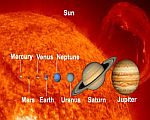- Home
- Subatomic Particles
Subatomic Particles - making up the Universe
Subatomic particles, as the name suggests, are tiny objects that constitute atoms, and others that are responsible for three of the four fundamental forces of the Universe (possibly all four, as we'll see).
In fact, this is the first major subdivision of these things.
This page will take you through all their weird and wonderful world and provide links to pages with further information. It might get a bit technical, but I'll try to keep it as simple as possible.
We'll also be considering a selection of subatomic particles that are, at the moment, just theorised and have yet to be discovered.
Mass Particles
All particles responsible for making up matter - a planet, a cup of tea, you and me - can be divided into two broad types, quarks and leptons and these are collectively known as fermions. Hang on, you might be thinking, from my physics lessons at school, I remember atoms being made of electrons, protons and neutrons. What's this "fermions" business? Well electrons are a type of lepton and the other two are made up of quarks.
Subatomic particles can also be "elementary", meaning they cannot be subdivided any further, or "composite", which implies that they are made up of other particles. Referring to the paragraph above, this means that an electron is an elementary particle, while protons and neutrons are composite.
Force Particles
It is generally thought in theoretical physics that all forces involve movement of particles and these are collectively known as bosons. To explain this a bit more clearly, light is made of particles called photons, but it can also have a wave-like quality and behave like a force.
There is a discovered boson for three of the four fundamental forces of the Universe and these are called "gauge bosons". The possible boson for the fourth force - gravity - has yet to be discovered.
You're probably thinking by now, what about the Higgs boson? That subatomic particle is not a gauge boson, but was required to exist for the Standard Model of particle physics to make sense, as its function is to impart mass to particles. On the 14th of March, 2013, an announcement from the Large Hadron Collider at CERN in Switzerland confirmed that a newly discovered particle was probably the Higgs boson.
Theoretical Particles
Theoretical physicists, by definition, spend their time theorising about physics and this includes thinking up other possible subatomic particles.
The Higgs boson was once an example, but appears to have finally been discovered. Another that could be as important as the Higgs is the graviton - the particle that governs the force of gravity.
However, there are other weird and wonderful theories of particles yet to be proved one way or the other and they have some great names.
More information on theoretical particles









Facebook Comments
Have your say about what you just read! Leave me a comment in the box below.